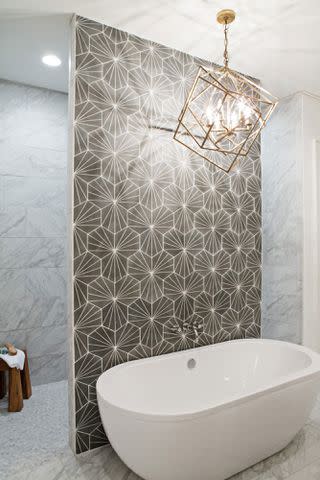All About Wet Rooms, The New Spa-Inspired Bathroom Trend We're Loving
Call up your contractor now.
The open floor plan first gained popularity by combining the kitchen, living, and dining areas into one cohesive space. Now the open concept is making its way into full bathrooms with wet rooms, a spa-like approach to designing your bath.
In its simplest form, a wet room is what it sounds like, which is a room designed to get wet. Specifically, a wet room does not have a separation between the shower and the rest of the bathroom floor. Both shower height and partitions are seamless throughout the space, creating a water-resistant space. Using tiles and other materials makes more efficient use of space and also creates a relaxing, spa-style experience for bathing. If you are considering installing a wet room, read the pros and cons of this open-concept bathroom.

Laurey W. Glenn; Styling: Buffy Hargett Miller
Pros Of Wet Rooms
Your Bathroom Feels Larger
Less is more, and this design trend is proof. Taking down barriers like extra walls smooths traffic flow. It increases efficiency while abandoning elements like mats and curtains, cutting down on visual clutter. The point? Removing all these physical distractions creates more space, no matter the actual size of your bathroom.
The Floorplan Is Accessible
Did you know that the bathroom is one of the most dangerous places in any residence? Whether due to aging or disability, we all reach a point when tasks like bathing become more time-consuming and difficult. Because the shower is level with the rest of the bathroom, there's nothing to step over. Having fewer things in general also helps keep movement uncomplicated through the years. Tip: Since you're renovating anyway, if you're in your forever home, this may be time to consider other accessible elements like grab bars or motion sensor lights.
Cleaning Is Easy
One significant benefit of a wet room setup is that you can direct all the water into a single drain, so no one's stopping you if you take your handheld shower head to the soaped-up floor (or maybe even the tiled walls). Given the minimalist design, there's less stuff to clean, and sleeker lines are easier to maintain.
It's Water Resistant
Those hot, steamy showers you love create the perfect environment for mold, mildew, and water decay. But with a wet room, there's not as much humidity because the bathing area isn't enclosed (though in a larger bathroom, this does mean you may feel a little colder). Another perk is because wet rooms are technically one oversized shower, the space is entirely waterproof, ensuring leaks and water damage are nonexistent.
Your Property Value Increases
A wet room is hard to say goodbye to, but you can expect to recoup 56-64% of the renovation costs if you ever sell your house. While this data refers to all well-renovated bathrooms, between the style, functionality, and minimal maintenance, any buyer will consider a wet room a win.

Cons Of Wet Rooms
Large Bathrooms Are Loud And Messy
With the minimalist design and materials, the acoustics are likely louder than usual. Also, dry areas like bathroom storage must be water-resistant as shower splashes occur. Things like towels, toilet paper, makeup, or other items usually stored in a bathroom need proper storage.
More Tile, More Renovation Costs
While tiled walls are a traditional wet room element, they increase renovation costs. In addition to extra tile, more ventilation is necessary when the entire room is susceptible to moisture. Fans will help ensure the moisture stays in the bathroom and does not make the floor slippery.
Wet Floors
As previously described, the shower is level with the flooring. The openness creates opportunities for water and moisture to stay on the floor, possibly making it easier to slip and fall. Proper drainage and ventilation are essential, but extra caution is necessary when adjusting to this new flooring construction.
Tips For Installing A Wet Room
If you decide to incorporate a wet room in your next bathroom renovation, there are a few special considerations to keep in mind for a space that's designed to get wet:
First, use an experienced contractor who has experience with installing water tight spaces. A waterproof membrane and hidden tray systems under the tile will go a long way toward preventing damage.
Though wet room showers are not enclosed, strategic placement of clear glass panels can prevent excess splashing and protect furnishings like your sink console.
Consider hanging toilets or sinks from the wall to make the room appear more spacious and keep them off the damp floor.
Be careful when choosing tile for a wet room floor. You don't want a surface that gets too slick or that can't hold up to cleaning agents. Opt for something textured or a natural stone surface.
Install a high-quality fan that will remove humidity effectively and help the floor dry faster.
For more Southern Living news, make sure to sign up for our newsletter!
Read the original article on Southern Living.

